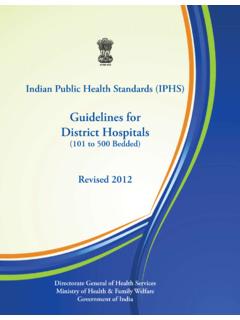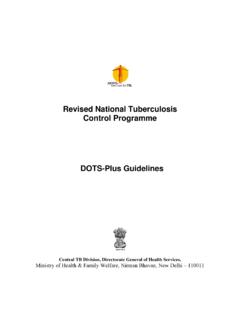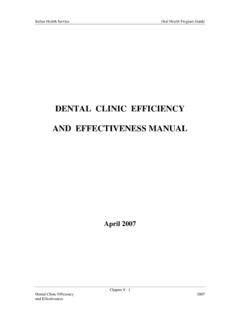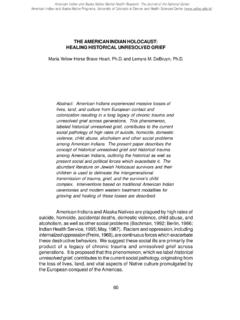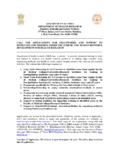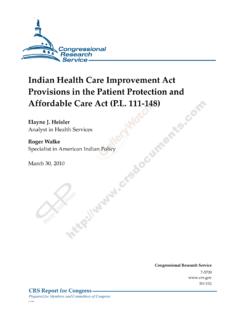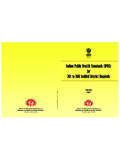Transcription of Indian Public Health Standards (IPHS) Guidelines for ...
1 Indian Public Health Standards (IPHS). Guidelines for Community Health Centres Revised 2012. Directorate General of Health Services Ministry of Health & Family Welfare Government of India Indian Public Health Standards (IPHS). Guidelines for Community Health Centres Revised 2012. Directorate General of Health Services Ministry of Health & Family Welfare Government of India Contents Message v Foreword vi Preface vii Acknowledgements viii Executive Summary 1. Indian Public Health Standards (IPHS) for Community Health Centres 3. Introduction 3. Objectives of Indian Public Health Standards (IPHS) for CHCs 3. Service Delivery in CHCs 3. Manpower 8. Equipment 11. Drugs 11. Physical Infrastructure 11. Quality Assurance in Service Delivery 16. Patient Safety and Infection Control 17. Statutory and Regulatory Compliance 18. Record Maintenance 18.
2 Checklists 18. Annexures Annexure 1: Newborn Care Facilities at Chc 20. Annexure 1A: Newborn Corner in OT/Labour Room 20. Annexure 1B: Newborn Care Stabilization Unit 22. Annexure 2: Requirements with Regard to Revised National TB Control Programme 24. Annexure 3: National Aids Control Programme: Guidelines 26. Annexure 4: National Vector Borne Disease Control Programme 27. Annexure 5: National Leprosy Eradication Programme 29. Annexure 6: National Programme for Control of Blindness 30. Annexure 7: Integrated Disease Surveillance Project 31. Annexure 7A: Form P (Weekly Reporting Format-IDSP) 32. Annexure 7B: Form L (Weekly Reporting Format-IDSP) 33. Annexure 7C: Format for Instantaneous Reporting of Early Warning Signal/Outbreaks . as soon as it is Detected 34. Annexure 8: Facility Based Maternal Death Review Form 35. Annexure 9: List of Equipment in CHC 39.
3 Annexure 10: List of Drugs 47. Annexure 11: Extracts from National Guidelines on Blood Storage Facilities at FRUs 65. Annexure 12: List of Diagnostic Services 68. Annexure 13: Model Citizen's Charter 71. Annexure 14: List of Statutory Compliances 73. Annexure 15: Steps for Safety in Surgical Patients (in the Pre-operative Ward) 74. Annexure 16: List of Abbreviations 76. References 78. Members of Task Force for Revision of IPHS 79. MESSAGE. National Rural Health Mission (NRHM) was launched to strengthen the Rural Public Health System and has since met many hopes and expectations. The Mission seeks to provide effective Health care to the rural populace throughout the country with special focus on the States and Union Territories (UTs), which have weak Public Health indicators and/or weak infrastructure. Towards this end, the Indian Public Health Standards (IPHS) for Sub-Centres, Primary Health Centres (PHCs), Community Health Centres (CHCs), Sub-District and District Hospitals were published in January/February, 2007 and have been used as the reference point for Public Health care infrastructure planning and up-gradation in the States and UTs.
4 IPHS are a set of uniform Standards envisaged to improve the quality of Health care delivery in the country. The IPHS documents have been revised keeping in view the changing protocols of the existing programmes and introduction of new programmes especially for Non-Communicable Diseases. Flexibility is allowed to suit the diverse needs of the states and regions. Our country has a large number of Public Health institutions in rural areas from sub-centres at the most peripheral level to the district hospitals at the district level. It is highly desirable that they should be fully functional and deliver quality care. I strongly believe that these IPHS Guidelines will act as the main driver for continuous improvement in quality and serve as the bench mark for assessing the functional status of Health facilities. I call upon all States and UTs to adopt these IPHS Guidelines for strengthening the Public Health Care Institutions and put in their best efforts to achieve high quality of Health care for our people across the country.
5 New Delhi (Ghulam Nabi Azad). Foreword As envisaged under National Rural Health Mission (NRHM), the Public Health institutions in rural areas are to be upgraded from its present level to a level of a set of Standards called Indian Public Health Standards (IPHS) . The Indian Public Health Standards are the benchmarks for quality expected from various components of Public Health care organizations and may be used for assessing performance of Health care delivery system. The Community Health Centres (CHCs) which constitute the secondary level of Health care were designed to provide referral as well as specialist Health care to the rural population. Indian Public Health Standards (IPHS) for CHCs were first released under National Rural Health Mission (NRHM) in . early 2007. As setting Standards is a dynamic process, need was felt to update the IPHS keeping in view the changing protocols of existing National Health Programmes, development of new programmes especially for non-communicable diseases and the prevailing epidemiological situation in the country.
6 The IPHS for CHC has been revised by a task force comprising of various stakeholders under the Chairmanship of Director General of Health Services. Subject experts, NGOs, State representatives and Health workers working in the Health facilities have also been consulted at different stages of revision. The newly revised IPHS (CHC) has considered the services, infrastructure, manpower, equipment and drugs in two categories of Essential (minimum assured services) and Desirable (the ideal level services which the states and UTs shall try to achieve). Unlike Sub-centre and PHCs, CHCs will be of one type only and will act as Block level Health administrative unit and Gatekeeper for referrals to higher level of facilities. I would like to acknowledge the efforts put by the Directorate General of Health Services in preparing the Guidelines .
7 It is hoped that this document will be useful to all the stakeholders. Comments and suggestions for further improvements are most welcome. ( ) . Preface Standards are a means of describing a level of quality that the Health care organizations are expected to meet or aspire to achieve. For the first time under National Rural Health Mission (NRHM), an effort had been made to develop Indian Public Health Standards (IPHS) for a vast network of peripheral Public Health institutions in the country and the first set of Standards was released in early 2007 to provide optimal specialized care to the community and achieve and maintain an acceptable standard of quality of care. The IPHS for Community Health Centres has been revised keeping in view the resources available with respect to functional requirements for a Community Health Centre with minimum Standards for such as building, manpower, instruments and equipment, drugs and other facilities etc.
8 The revised IPHS has also incorporated the changed protocols of the existing Health programmes and new programmes and initiatives especially in respect of Non-Communicable Diseases. The task of revision was completed as a result of consultations held over many months with task force members, programme officers, Regional Directors of Health and Family Welfare, experts, Health functionaries, representatives of Non-Government organizations, development partners and State/Union Territory Government representatives after reaching a consensus. The contribution of all of them is well appreciated. Several innovative approaches have been incorporated in the management process to ensure community and Panchayati Raj Institutions' involvement and accountability. Under the revised IPHS, CHC serves as a First Referral Unit, Block level Administrative Unit and Block level Public Health Unit.
9 This document prescribes the essential requirements for a minimum functional grade of a Community Health Centre and the desirable requirements needed for an ideal situation. Setting Standards is a dynamic process and this document is not an end in itself. Further revision of the Standards shall be undertaken as and when the Community Health Centres will achieve a minimum functional grade. It is hoped that this document will be of immense help to the States/Union Territories and other stakeholders in bringing up the Community Health Centres to the level of Indian Public Health Standards . (Dr. Jagdish Prasad). Acknowledgements The revision of the existing Guidelines for Indian Public Health Standards (IPHS) for different levels of Health Facilities from Sub-Centre to District Hospitals was started with the formation of a Task Force under the Chairmanship of Director General of Health Services (DGHS).
10 This revised document is a concerted effort made possible by the advice, assistance and cooperation of many individuals, Institutions, government and non- government organizations. I gratefully acknowledge the valuable contribution of all the members of the Task Force constituted to revise Indian Public Health Standards (IPHS). The list of Task Force Members is given at the end of this document. I am thankful to them individually and collectively. I am truly grateful to Mr. Pradhan, Secretary (H & FW) for the active encouragement received from him. I also gratefully acknowledge the initiative, inspiration and valuable guidance provided by Dr. Jagdish Prasad, Director General of Health Services, Ministry of Health and Family Welfare, Government of India. He has also extensively reviewed the document while it was being developed.
